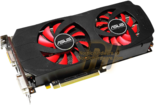- Joined
- Oct 9, 2007
- Messages
- 47,242 (7.55/day)
- Location
- Hyderabad, India
| System Name | RBMK-1000 |
|---|---|
| Processor | AMD Ryzen 7 5700G |
| Motherboard | ASUS ROG Strix B450-E Gaming |
| Cooling | DeepCool Gammax L240 V2 |
| Memory | 2x 8GB G.Skill Sniper X |
| Video Card(s) | Palit GeForce RTX 2080 SUPER GameRock |
| Storage | Western Digital Black NVMe 512GB |
| Display(s) | BenQ 1440p 60 Hz 27-inch |
| Case | Corsair Carbide 100R |
| Audio Device(s) | ASUS SupremeFX S1220A |
| Power Supply | Cooler Master MWE Gold 650W |
| Mouse | ASUS ROG Strix Impact |
| Keyboard | Gamdias Hermes E2 |
| Software | Windows 11 Pro |
Towards the end of March, we caught a glimpse of a yet to be named high-end custom-designed Radeon HD 4890 accelerator from ASUS. The accelerator makes use of an exotic VRM design to facilitate high clock speeds and overclocking potential. Back then, we couldn't get pictures of what cooled the beast. Thankfully, NordicHardware has a few pictures of the cooler, along with more details in place.

The cooler is a complex piece of engineering. It consists of a central copper GPU contact base from which six 230 mm long copper heatpipes distribute heat between the GPU and VRM areas, which have large heatsinks of their own. Two fans of dissimilar sizes are suspended on the shroud. The larger one, over the GPU, rotates clockwise, while the other counterclockwise. Looking at ASUS' design methods with high-end cards, we can safely guess the fans are controlled by a complex controller that adjusts fan speeds on a per-fan basis, depending on the temperatures of the various zones of this card.
From what the source tells, this cooler should run the card at least 10 °C cooler than what the reference cooler manages. This may facilitate stock clock speeds in excess of 900 MHz for the core, and 1000 MHz for the memory. Some credit of the electrical stability of the core at those speeds goes to the use of the Fujitsu-made SuperML capacitor, that reduces voltage noise by as much as 20% (from 143mV to 114mV). Regarding the exact brand name of this card, we can confirm that the card will not carry the "MATRIX" branding. The other high-end term ASUS uses, "TOP", has already been used for a factory-overclocked reference design accelerator, leaving the brand name yet to be disclosed.
View at TechPowerUp Main Site

The cooler is a complex piece of engineering. It consists of a central copper GPU contact base from which six 230 mm long copper heatpipes distribute heat between the GPU and VRM areas, which have large heatsinks of their own. Two fans of dissimilar sizes are suspended on the shroud. The larger one, over the GPU, rotates clockwise, while the other counterclockwise. Looking at ASUS' design methods with high-end cards, we can safely guess the fans are controlled by a complex controller that adjusts fan speeds on a per-fan basis, depending on the temperatures of the various zones of this card.
From what the source tells, this cooler should run the card at least 10 °C cooler than what the reference cooler manages. This may facilitate stock clock speeds in excess of 900 MHz for the core, and 1000 MHz for the memory. Some credit of the electrical stability of the core at those speeds goes to the use of the Fujitsu-made SuperML capacitor, that reduces voltage noise by as much as 20% (from 143mV to 114mV). Regarding the exact brand name of this card, we can confirm that the card will not carry the "MATRIX" branding. The other high-end term ASUS uses, "TOP", has already been used for a factory-overclocked reference design accelerator, leaving the brand name yet to be disclosed.
View at TechPowerUp Main Site
Last edited:








 Cooler looks nice, I prefer blue though. I would get a 4890 as it's only a tenner more than a 1GB 4870 Vapor-X I'm planning to buy, but the stock coolers suck big time and no doubt the 4890s with custom coolers will be a lot more expensive
Cooler looks nice, I prefer blue though. I would get a 4890 as it's only a tenner more than a 1GB 4870 Vapor-X I'm planning to buy, but the stock coolers suck big time and no doubt the 4890s with custom coolers will be a lot more expensive 

